Dec 1 2012
Stegosaurus calendar: 2013 edition
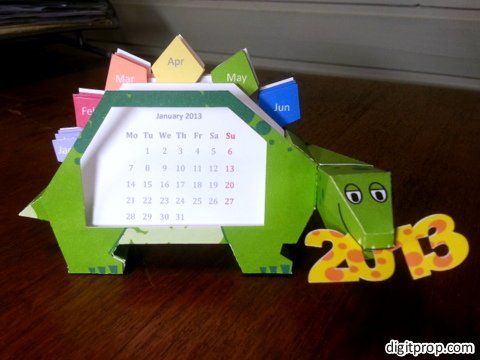
Just in time for the end of this year (and Christmas, in case you want to make this as a gift for someone), I have updated the stegosaurus calendar (you will find the template for the stegosaurus itself behind this link).
This time, I have decided to make cards for a weekly calendar as well as for a monthly one:


The weekly calendar allows for notices and appointments to be added to the cards, but is a lot of work. After all, you have to print and cut out 52 cards.
Here are the PDFs:
Dec 1 2012
Phone directory cards for the stegosaurus
Another use for the stegosaurus
calendar is as a telephone directory. Here are suitable cards:
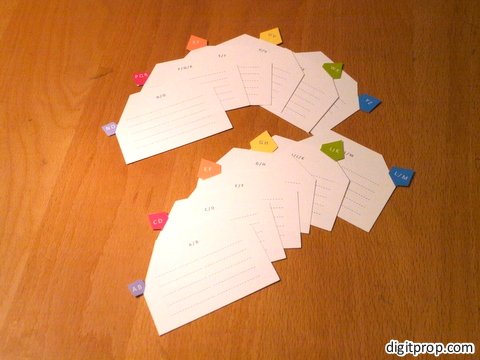
Actually, the use as a directory and calendar is not mutually exclusive: You can put the calendar cards in front, and the directory cards behind them:

And here is the PDF.

Actually, the use as a directory and calendar is not mutually exclusive: You can put the calendar cards in front, and the directory cards behind them:

And here is the PDF.
Dec 1 2012
Blank cards for the stegosaurus
You may remember the stegosaurus
calendar. In addition to its use as a calendar, you can do all kinds of
other things with it. In order to facilitate this ‘hacking’, I have prepared a
template for blank cards:
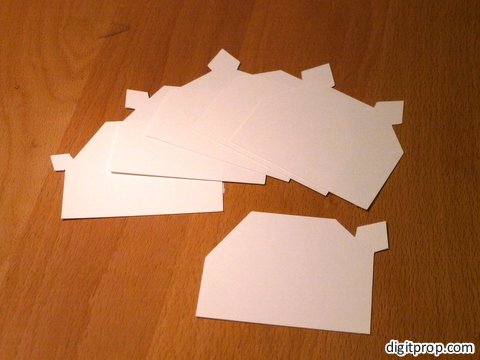
Here is the PDF.

Here is the PDF.
Dec 1 2012
Tutorial: How to build the stegosaurus calendar
Here is a quick photo tutorial for those of you who want to build the stegosaurus
calendar.
Very importantly, make sure that you use thick enough cardboard. Something in the range of 300 g/sqm is fine. If the cardboard / paper is too light, the model will easily warp and the cards may no longer fit.
Start with cutting out all parts: Note that there is one part (for the tail) which is inside the right side part. It’s highly recommended to use an X-acto or similar crafts knife.
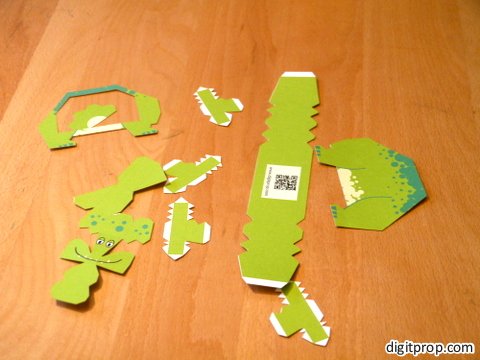
Next, fold the long center piece and glue it to the side with the “window”. Make sure that the walls are parallel and leave enough space for the cards.

Attach the other side:
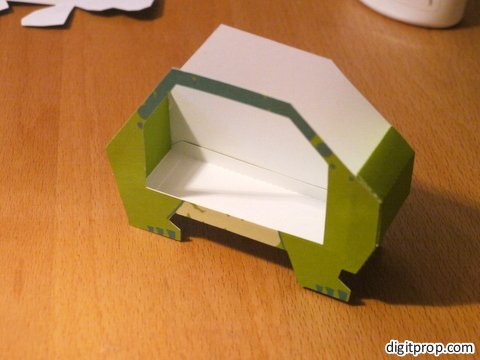
Next, assemble the four feet:
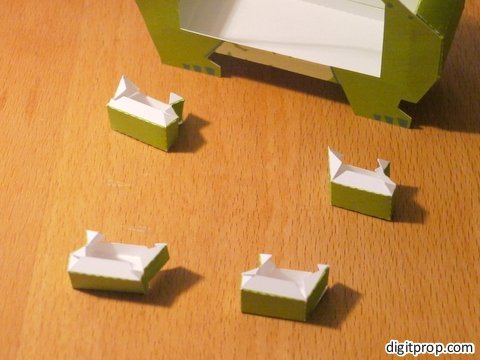
… and glue them to the body:
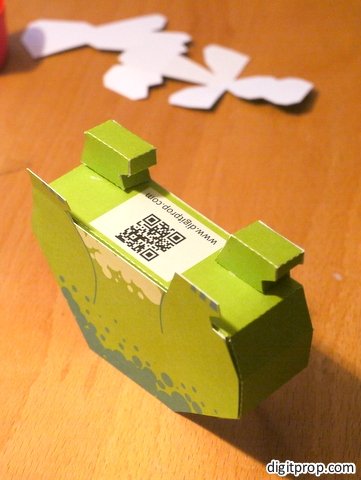

Then attach the tail:
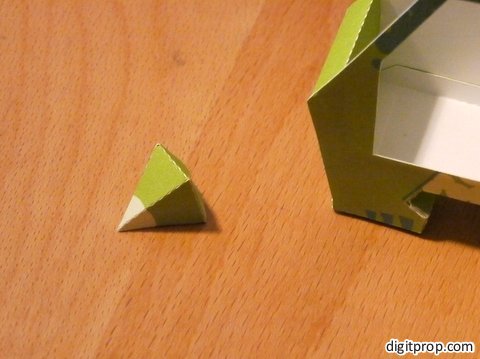
Now on to the head: This looks more complicated than it is. First, before you start assembling the head, cut a slit where the mouth is.
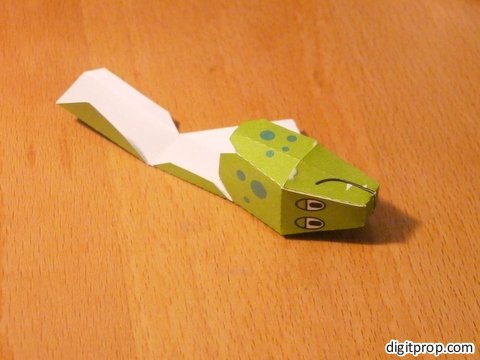
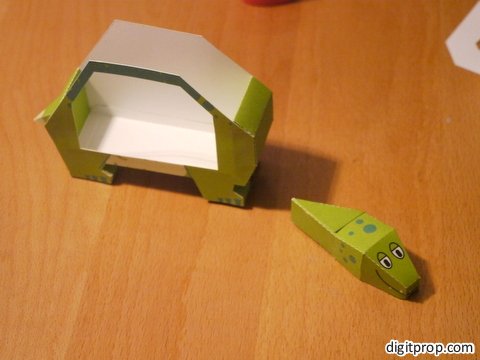
If you are a perfectionist and have a good knife, you can cut out the year and put it into the dinosaur’s mouth:
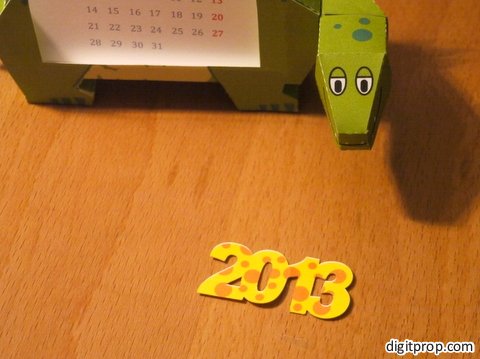

… and you’re done:

Here is the link to the original template.
Very importantly, make sure that you use thick enough cardboard. Something in the range of 300 g/sqm is fine. If the cardboard / paper is too light, the model will easily warp and the cards may no longer fit.
Start with cutting out all parts: Note that there is one part (for the tail) which is inside the right side part. It’s highly recommended to use an X-acto or similar crafts knife.

Next, fold the long center piece and glue it to the side with the “window”. Make sure that the walls are parallel and leave enough space for the cards.

Attach the other side:

Next, assemble the four feet:

… and glue them to the body:


Then attach the tail:

Now on to the head: This looks more complicated than it is. First, before you start assembling the head, cut a slit where the mouth is.


If you are a perfectionist and have a good knife, you can cut out the year and put it into the dinosaur’s mouth:


… and you’re done:

Here is the link to the original template.
Nov 29 2012
Nativity scene update: The wisemen
I had some requests for adding the wisemen to the nativity
scene template I posted about a year ago. So right before Advent Sunday,
here they are:
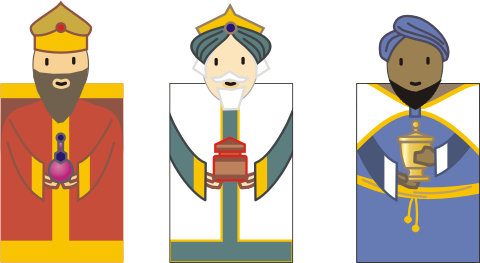
See the original post for the downloadable PDF template.

See the original post for the downloadable PDF template.
Oct 25 2012
Lucky cat – alternative design
Following up on my previous post of a Maneki Neko / Lucky
Cat, here is an alternative design courtesy of my five year old daughter (if
you are more interested in the original, more traditionally textured model, click here):

She decorated a blank test model with a black felt-tip pen. This is probably just a father’s biased pride, but I very much like the black and white minimalism.

Since I was quite fond of the design, I carefully disassembled the model, scanned the pieces and created a new template.

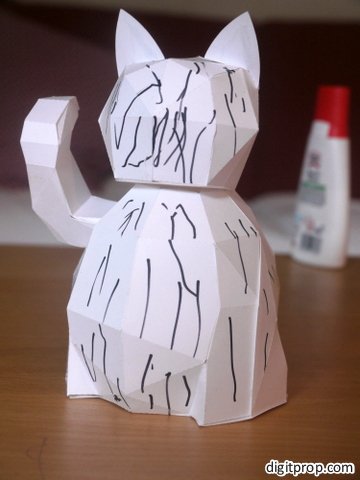
Here are the PDFs:

She decorated a blank test model with a black felt-tip pen. This is probably just a father’s biased pride, but I very much like the black and white minimalism.

Since I was quite fond of the design, I carefully disassembled the model, scanned the pieces and created a new template.


Here are the PDFs:
Oct 21 2012
Halloween special – papercraft skeleton
Oct 18 2012
Maneki Neko – Lucky cat
Finally a new model, and frankly one that I’m a bit proud of – after all, it did require quite some work to get it right in the end. And it’s my first one with movable parts. It’s a lucky or beckoning cat, popular in Japan and China (where I got the inspiration, when I was travelling there).
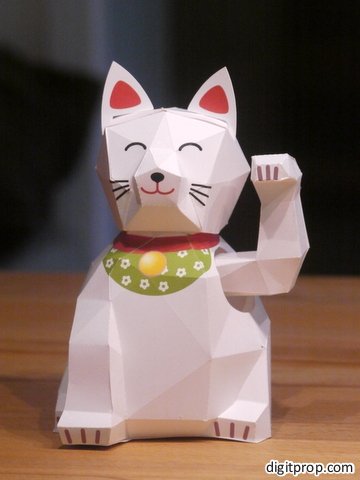
The beckoning cat is supposed to bring luck and wealth. This one can actually move its arm. Here is a video:
The underlying mechanism is actually quite simple and consists mainly of a small paper pendulum with a coin as weight.
Here are some more pics of the assembled cat:
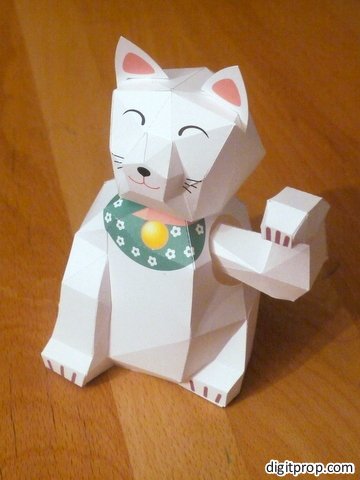

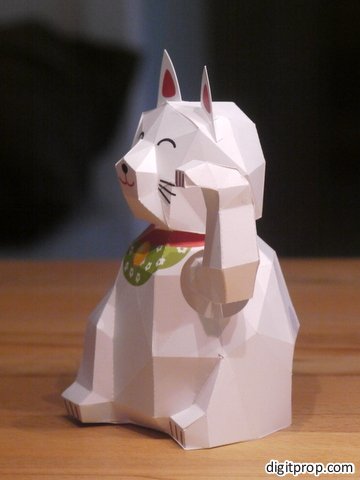

I have to admit this was the most difficult model to design so far, and it is quite tricky to build – especially the mechanism for the arm. You have to pay attention to allow the arm to rotate freely. Any friction will cause it to stop rocking back and forth.
In addition, the whole model is a bit complex for beginners, and it is important to build everything in the right order – otherwise you may paint yourself into a corner. Here is a photo tutorial:
Start with the mechanism for the arm. In order to keep things nice and clean, this is a standalone contraption that later goes inside the actual cat body. Here are the parts:
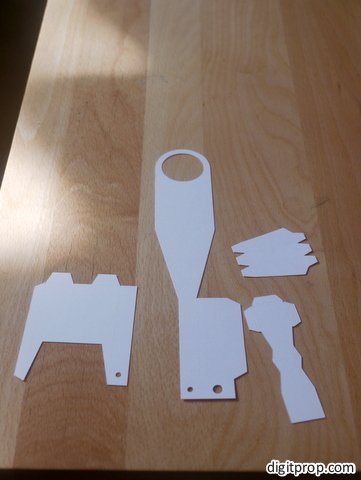
First, build a holder:
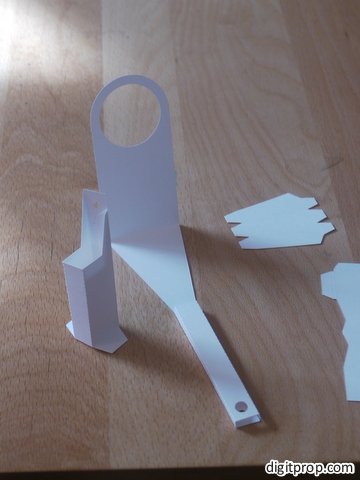

Now assemble the left arm, but leave one side open yet:
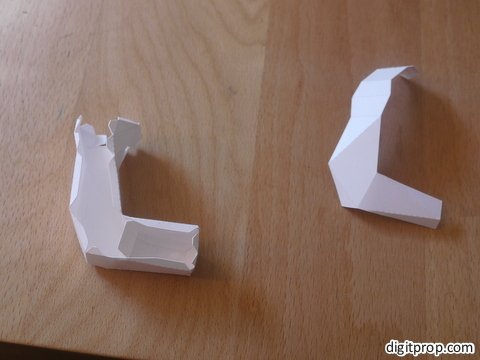
There is a small square with a hole in the middle. This goes into the upper arm and is intended for holding and stabilizing the stick that later will hold the arm in place. Take a wooden stick about3 mm in diameter, wooden skewers are perfect. Insert it carefully into the arm, like so:
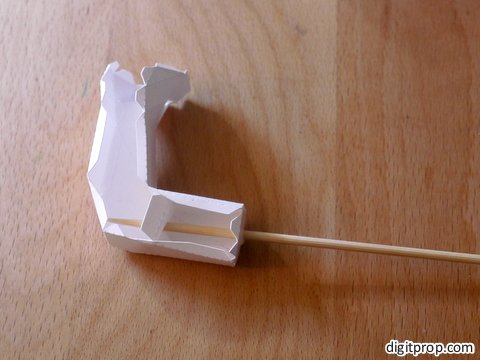
Now glue the missing face to the arm. Then insert it carefully into the holder:

Make sure it rotates freely, without any friction. Shorten the skewer so that it is a bit longer than the holder. If it is too long, it will not fit into the body, so be careful.
Next, assemble the head:
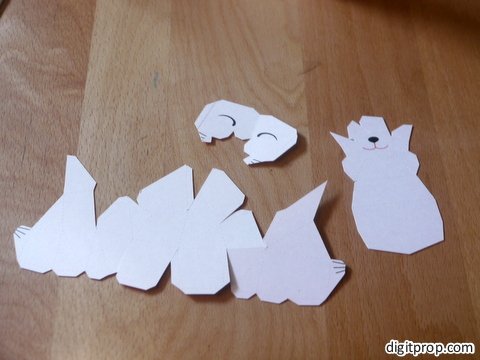
First, take the largest part and glue it into a helmet shape:

Now take the two smaller parts and glue them together. This will form the face:
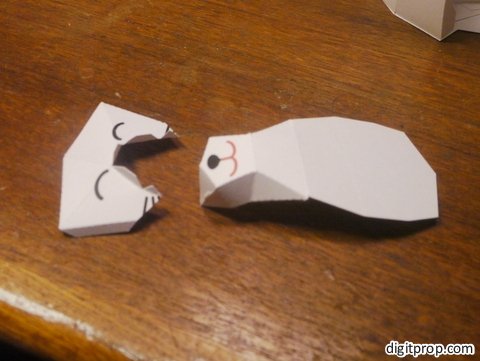
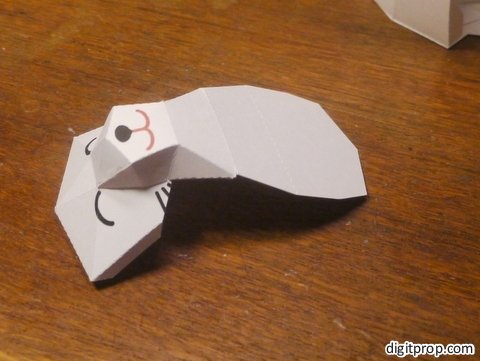
Now glue the face into the “helmet”, and finally close the head with the bottom part. Then attach the ears:

Ok, onto the final part – the body. In a first step, build the front half only, starting with these parts for the right side and hind leg:
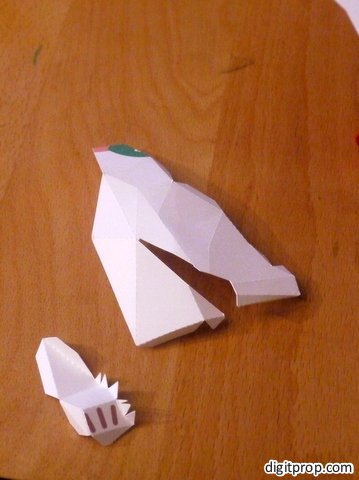
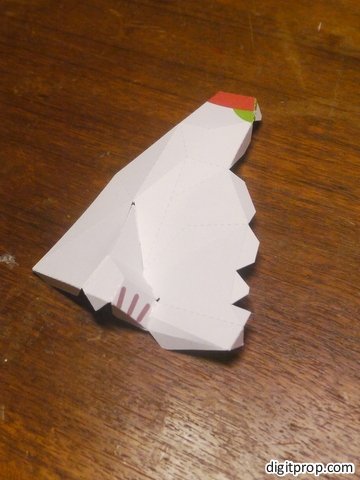
Continue with the front:

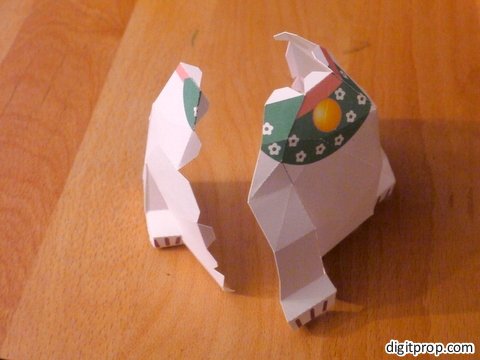
… and add the left side, which includes the hole for the left arm. You will end up with something like a hemisphere:
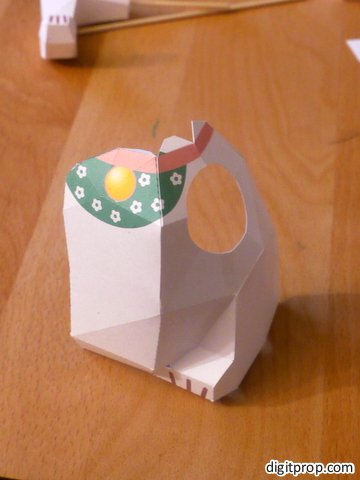
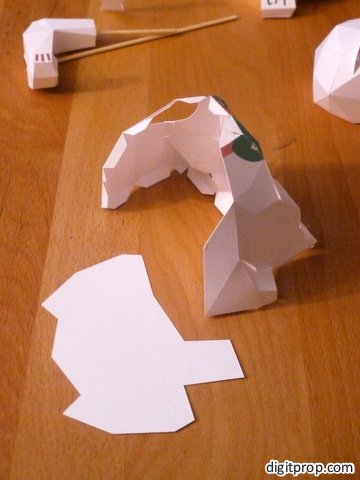
Now glue this hemisphere onto the base plate:

Now place the holder for the arm into the body. Align the ring with the hole for the arm, then glue the holder to the base plate and the ring to the hole – this will ensure that the arm is firmly centered in the hole.
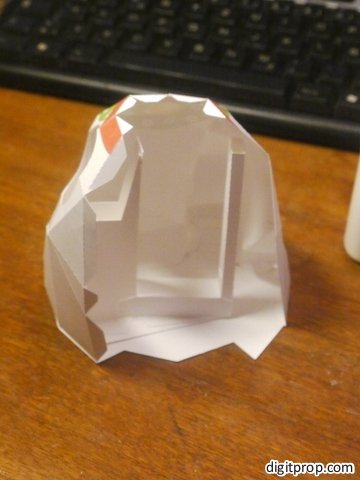
Now you can insert the arm:
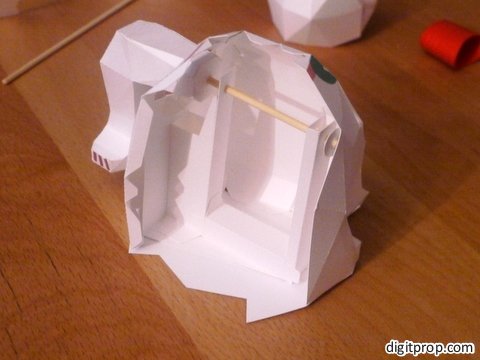
Ensure that the arm can rotate freely. Then lock the skewer in place by glueing the small disk to the end. Now it’s time to attach the pendulum weight. You will need a small coin as a weight:
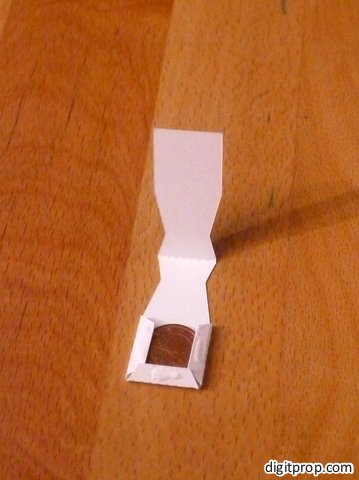

Make sure that the arm is in the right position (upwards) when the weight is attached. Also, test that everything works smoothly. The arm should swing back and forth when you tip it.
If everything is ok, you can glue the backside in place:

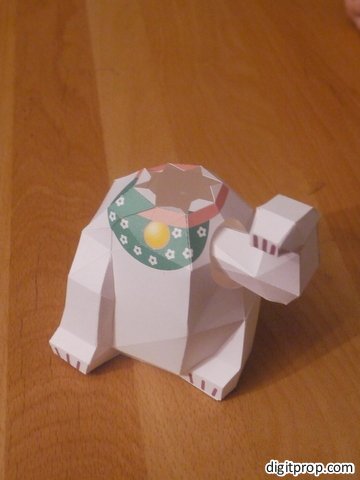
Alright – almost there. The only thing left is to attach the head, and you are done:

Here is the template:
By the way, there are Maneki Nekos with either the left or right arm up. The significance is not universally clear, but if you want a cat with the right arm up, you can print out the templates mirrored. Most printer drivers allow for this option, sometimes called ‘T shirt transfer’.
Sep 7 2012
Peacock penholder
I admit this is “somewhat” kitschy, but it can still make for a nice little
gift for children, if you want to give them a set of pencils or felt-tip pens
(kids love kitsch). It’s a peacock pen-holder:
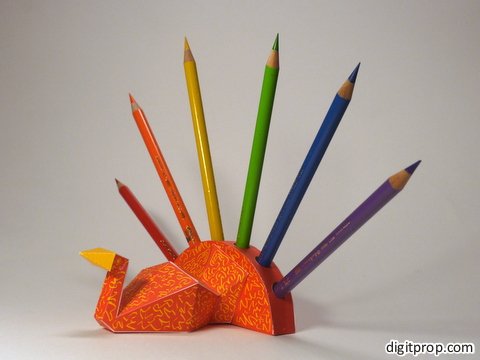
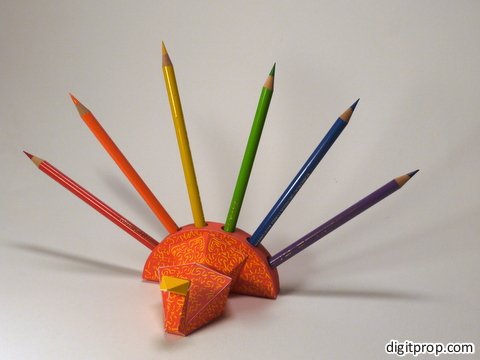
In case you wonder what the golden scribbles mean, and if they maybe are the next Voynich manuscript, I have to disappoint you: They are just that – decorative scribbles.

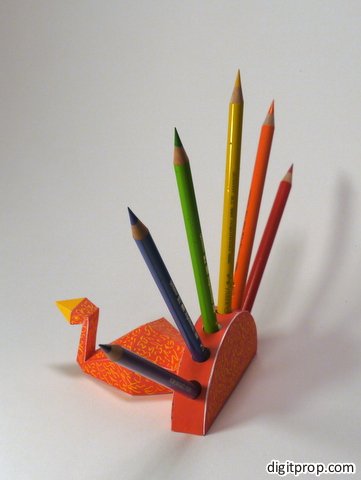

Now, making this model is a bit complicated, so I decided to make a small photo tutorial. The model consists of two pages. Page 1 contains the body, page 2 contains the peacock’s fan.
Start with the body. Score and cut out all three parts:
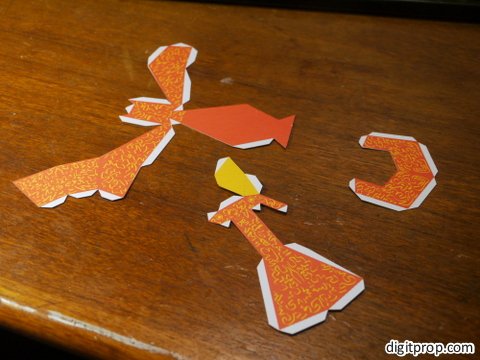
The larget part forms the body and neck. Glue the sides to the base, in order to get a ‘boat-like’ structure. Do not glue the remaining sides yet:

Glue the head, including the yellow beak. The head is small and detailed, so take time and be careful.

Now insert the back side of the neck and the top of the body into the previously made ‘boat’, and carefully glue the neck and head to the body:

After that, you are almost done with the body.
Now, very importantly, I suggest adding small weights to the base. Just glue one or two small coins inside, close to where the neck begins. Otherwise, the weight of the pencils being at the back end of the model, the peacock will be prone to tipping over.
Glue the remaining flaps and get something like this:
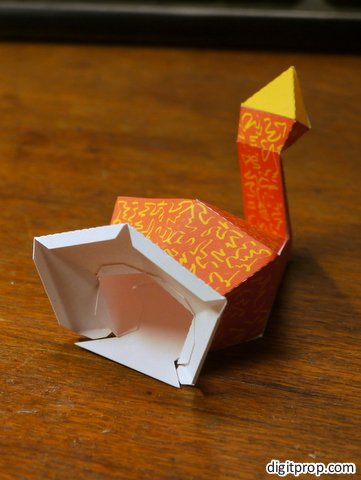
Now it’s time to start working on the fan: Cut out the holes in the strip, then glue it to the main ‘taco-shaped’ part, but leave one side open:

We have to insert separator tabs, so that the pencils stay in their intended positions. Otherwise they will stick out at arbitrary angles and don’t form a nice fan. Thus, glue the tabs radially into the base:
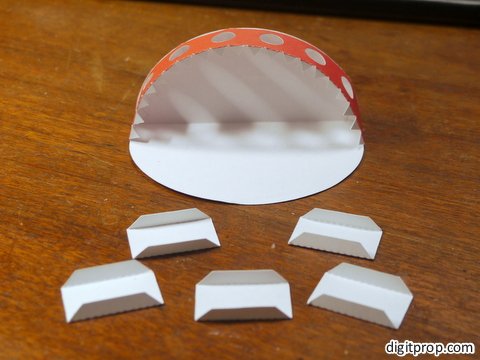
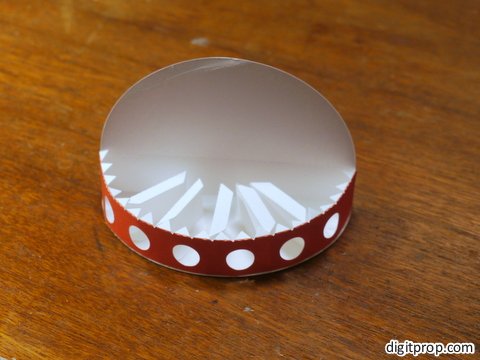
This doesn’t have to be 100% accurate and symmetrical. The important thing is to provide some guidance for the pencils and keep them separated. Now glue the base of the fan shut, and attach it to the body:

Congratulations – you are done. Just add six pencils, and there you have your red-golden peacock. You will notice that adding just one pencil in the leftmost or rightmost position will make the model fall over, so add them symmetrically.
This is also a caveat: As nice as the peacock is, it’s probably not the most usable pen holder for daily use. Consider it more as a decorative accessory or for presenting a gift (and don’t sue me if after your hard work on building the peacock, it doesn’t hold up to your heavy duty office demands).
Here is the template:


In case you wonder what the golden scribbles mean, and if they maybe are the next Voynich manuscript, I have to disappoint you: They are just that – decorative scribbles.



Now, making this model is a bit complicated, so I decided to make a small photo tutorial. The model consists of two pages. Page 1 contains the body, page 2 contains the peacock’s fan.
Start with the body. Score and cut out all three parts:

The larget part forms the body and neck. Glue the sides to the base, in order to get a ‘boat-like’ structure. Do not glue the remaining sides yet:

Glue the head, including the yellow beak. The head is small and detailed, so take time and be careful.

Now insert the back side of the neck and the top of the body into the previously made ‘boat’, and carefully glue the neck and head to the body:

After that, you are almost done with the body.
Now, very importantly, I suggest adding small weights to the base. Just glue one or two small coins inside, close to where the neck begins. Otherwise, the weight of the pencils being at the back end of the model, the peacock will be prone to tipping over.
Glue the remaining flaps and get something like this:

Now it’s time to start working on the fan: Cut out the holes in the strip, then glue it to the main ‘taco-shaped’ part, but leave one side open:

We have to insert separator tabs, so that the pencils stay in their intended positions. Otherwise they will stick out at arbitrary angles and don’t form a nice fan. Thus, glue the tabs radially into the base:


This doesn’t have to be 100% accurate and symmetrical. The important thing is to provide some guidance for the pencils and keep them separated. Now glue the base of the fan shut, and attach it to the body:

Congratulations – you are done. Just add six pencils, and there you have your red-golden peacock. You will notice that adding just one pencil in the leftmost or rightmost position will make the model fall over, so add them symmetrically.
This is also a caveat: As nice as the peacock is, it’s probably not the most usable pen holder for daily use. Consider it more as a decorative accessory or for presenting a gift (and don’t sue me if after your hard work on building the peacock, it doesn’t hold up to your heavy duty office demands).
Here is the template:
Aug 4 2012
Tutorial on making the alphabet letters
I noticed that the papercraft
alphabet created some interest among people who are not (yet) experienced in
papercrafting. Therefore, some letters turned out to be a bit too difficult for
some, which prompted me to write this little tutorial. The idea is to give you
pointers as to where to start.
For the tutorial, I have chosen the ‘R’, as it is one of the more difficult letters due to the curved shape and the inner hole. Print the PDF template onto a sheet of paper or – preferably – cardstock. I use 190g/sqm (about 53 lb) cardstock. Please notice that the strength of the paper should match the size of the model. The letters are about 6cm (2.4 in) high, so 190g / 53 lb is already a bit on the heavy side. For larger models, the paper should be even stronger.
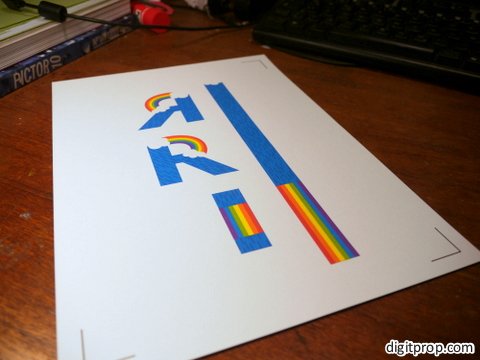
You can print with any printer. Using a laser printer leads to color that is less prone to smearing when getting into contact with glue or water, but inkjet printers usually have nicer colors and gradients.
Originally I said that the first step after printing is to cut out all parts. However, Carol rightfully pointed out in the comments that it might be easier to first score the pieces in the uncut template, and then cut them out. In this way, it is easier to align the scoring tool.
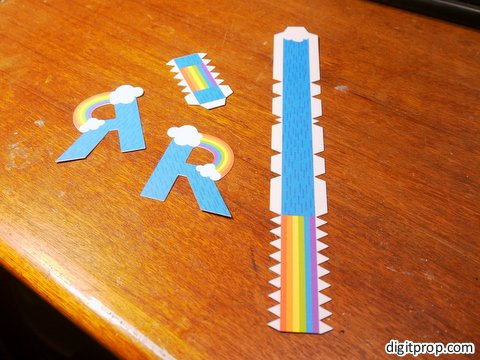
This can be done with a pair of scissors, but for details and holes it is useful to use an Xacto knife or similar sharp, pointed tool. However, please be careful with these: They are much more dangerous than scissors and shouldn’t be given to children.
the next step is to score along the dotted lines, so that the paper doesn’t break when you fold it. This can be done with any object that is pointed but not too sharp. the tip of scissors works reasonably well. In order to score precisely, it’s a good idea to align the tool with a ruler along the straight edges (except for curved parts, of course, where you and your steady hand are on your own):

There is also a dedicated tool for this job, called a bone folder (although these days it’s made from plastics). This is not really required, but if you want to do a lot of papercrafting, it can be a good investment (and it’s really unexpensive). It can be bought in all reasonably well-assorted crafting stores.

Carol suggests to use a knitting needle, which – if you have access to one, which I don’t – might in fact be even better suited – excellent suggestion, Carol!
The next step is to fold everything along the dotted lines. There are mountain folds and valley folds. They are not specifically indicated, but it’s usually easy to determine which is which by looking at how the parts fit together.
With most letters, you have the two faces and a strip that forms the edge. The ‘R’ is no difference – except that it has two strips, one for the hole and one for the outer edge. If you look at how the edge strip aligns with the faces, it is easy to figure out which folds are mountain folds and which are valley folds.
However, even if you make a mistake and fold into the wrong direction, this can be rectified later – once the paper has been folded in one direction, it easily folds back into the other direction as well.

Now it’s time to glue the parts together. For the ‘R’, we start with glueing the inner edge into a circular shape. Make sure that the printed side faces inwards. Then, apply glue to the flaps on one side only:
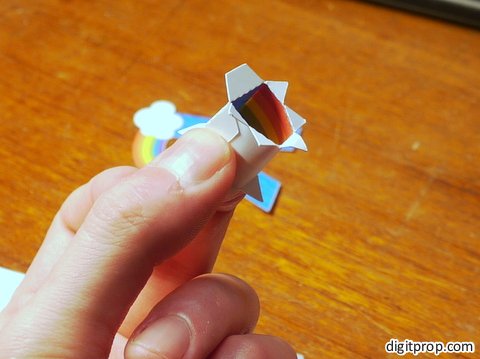
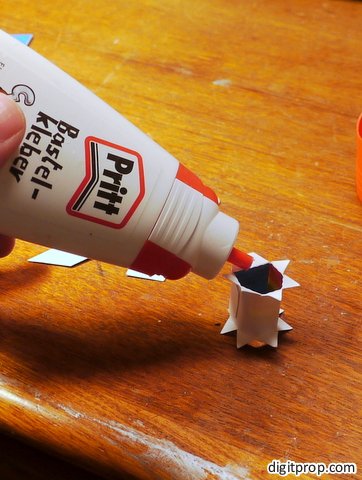
By the way, speaking of glue: The type of glue doesn’t really matter, you can use any glue suitable for paper. I personally use white ‘crafting’ glue which dries quickly, but not too quickly to realign parts, and is not too runny. It becomes transparent when fully dried, so small smudges aren’t that tragic. However, the paper gets dirty very quickly when covered in glue, and the glue tends to solubilize the printer color (for inkjet dyes at least) – so be carefuly and keep your hands as clean as possible. Perfectionists don’t apply the glue directly out of the dispenser, but with toothpicks.
Glue the part to one of the faces, and make sure that it aligns nicely with the edge of the face:
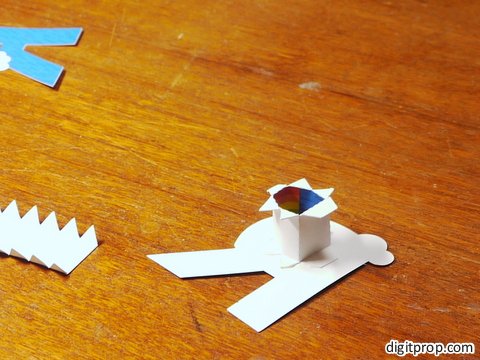
Now, apply glue to the flaps on one side of the outer strip, and section by section, glue it to the same face. You will end up with this:

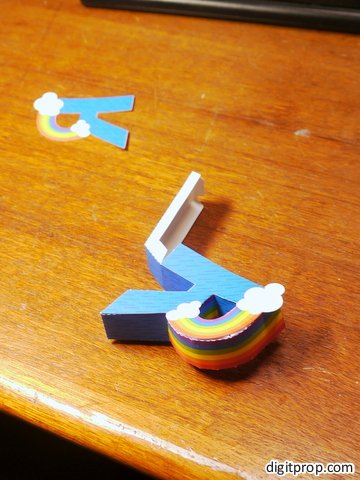

You may notice that the whole shape bends slightly, due to the uneven stress on the paper. This will be corrected by the next step: Simply apply glue to all remaining flaps, place the other face onto them and pull and push everything into shape.

That’s it. The whole process is actually not difficult, but takes some time getting used to it. The most important ‘trick’ is to be patient: Apply glue to one section / flap at a time, hold it in place until the glue sticks, then move on to the next piece.
For the tutorial, I have chosen the ‘R’, as it is one of the more difficult letters due to the curved shape and the inner hole. Print the PDF template onto a sheet of paper or – preferably – cardstock. I use 190g/sqm (about 53 lb) cardstock. Please notice that the strength of the paper should match the size of the model. The letters are about 6cm (2.4 in) high, so 190g / 53 lb is already a bit on the heavy side. For larger models, the paper should be even stronger.

You can print with any printer. Using a laser printer leads to color that is less prone to smearing when getting into contact with glue or water, but inkjet printers usually have nicer colors and gradients.
Originally I said that the first step after printing is to cut out all parts. However, Carol rightfully pointed out in the comments that it might be easier to first score the pieces in the uncut template, and then cut them out. In this way, it is easier to align the scoring tool.

This can be done with a pair of scissors, but for details and holes it is useful to use an Xacto knife or similar sharp, pointed tool. However, please be careful with these: They are much more dangerous than scissors and shouldn’t be given to children.
the next step is to score along the dotted lines, so that the paper doesn’t break when you fold it. This can be done with any object that is pointed but not too sharp. the tip of scissors works reasonably well. In order to score precisely, it’s a good idea to align the tool with a ruler along the straight edges (except for curved parts, of course, where you and your steady hand are on your own):

There is also a dedicated tool for this job, called a bone folder (although these days it’s made from plastics). This is not really required, but if you want to do a lot of papercrafting, it can be a good investment (and it’s really unexpensive). It can be bought in all reasonably well-assorted crafting stores.

Carol suggests to use a knitting needle, which – if you have access to one, which I don’t – might in fact be even better suited – excellent suggestion, Carol!
The next step is to fold everything along the dotted lines. There are mountain folds and valley folds. They are not specifically indicated, but it’s usually easy to determine which is which by looking at how the parts fit together.
With most letters, you have the two faces and a strip that forms the edge. The ‘R’ is no difference – except that it has two strips, one for the hole and one for the outer edge. If you look at how the edge strip aligns with the faces, it is easy to figure out which folds are mountain folds and which are valley folds.
However, even if you make a mistake and fold into the wrong direction, this can be rectified later – once the paper has been folded in one direction, it easily folds back into the other direction as well.

Now it’s time to glue the parts together. For the ‘R’, we start with glueing the inner edge into a circular shape. Make sure that the printed side faces inwards. Then, apply glue to the flaps on one side only:


By the way, speaking of glue: The type of glue doesn’t really matter, you can use any glue suitable for paper. I personally use white ‘crafting’ glue which dries quickly, but not too quickly to realign parts, and is not too runny. It becomes transparent when fully dried, so small smudges aren’t that tragic. However, the paper gets dirty very quickly when covered in glue, and the glue tends to solubilize the printer color (for inkjet dyes at least) – so be carefuly and keep your hands as clean as possible. Perfectionists don’t apply the glue directly out of the dispenser, but with toothpicks.
Glue the part to one of the faces, and make sure that it aligns nicely with the edge of the face:

Now, apply glue to the flaps on one side of the outer strip, and section by section, glue it to the same face. You will end up with this:



You may notice that the whole shape bends slightly, due to the uneven stress on the paper. This will be corrected by the next step: Simply apply glue to all remaining flaps, place the other face onto them and pull and push everything into shape.

That’s it. The whole process is actually not difficult, but takes some time getting used to it. The most important ‘trick’ is to be patient: Apply glue to one section / flap at a time, hold it in place until the glue sticks, then move on to the next piece.
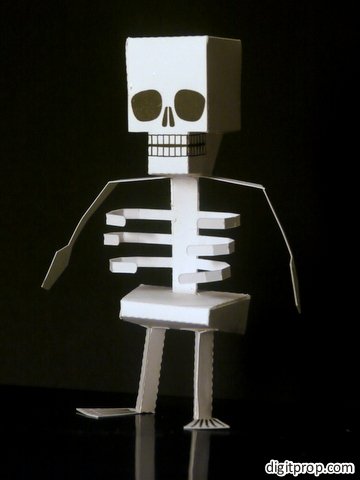
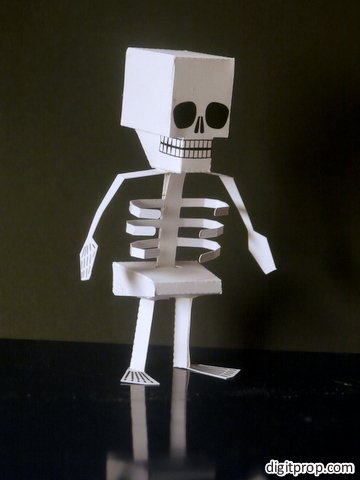
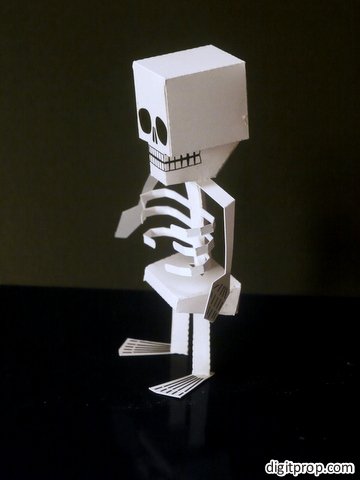
EXSELENT...THANKS MY FRIENDS!
ReplyDeleteЧеститки за блогот.
ReplyDeletewww.toveles.blogspot.com